Episode 221
What you’ll learn in this episode:
- How to use Antique Jewelry University to identify maker’s marks and find out when your jewelry was made.
- Why access to more (and better) information has made interest in antique jewelry explode.
- What characteristics Suzanne looks for when evaluating antique jewelry.
- Why buyers should beware of lab-grown diamonds in vintage jewelry.
- Why modern diamonds and manufacturing techniques can’t compare to the materials and skills used by jewelers in the past.
About Suzanne Martinez
Suzanne Martinez is the co-owner of Lang Antiques, a San Francisco-based shop that offers the largest collection of fine vintage engagement rings and antique jewels to be found under one roof. She is a highly credentialed senior gemologist, jewelry appraiser, jewelry historian and the curator for Lang’s collection. She actively buys from sellers all over the world. Suzanne is also the founder of Lang’s Antique Jewelry University.
Suzanne started collecting rocks and minerals as a child, and by the time she was 13 knew that the jewelry world was her passion. For fun she makes enameled jewelry and studies natural history and Latin American cultural anthropology.
Images courtesy of Lang Antique & Estate Jewelry:
Lang Vintage Engagement Rings
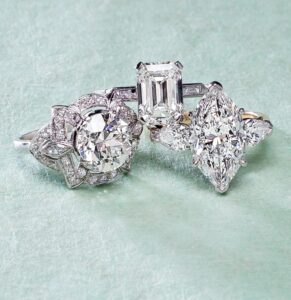
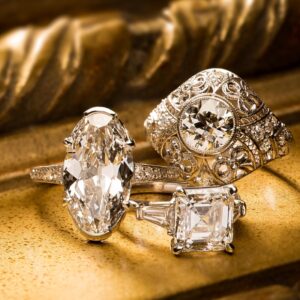
Lang Victorian Star Sapphire Necklace
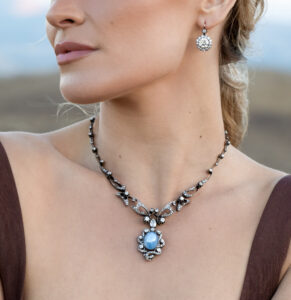
Retro Bracelet Stacks
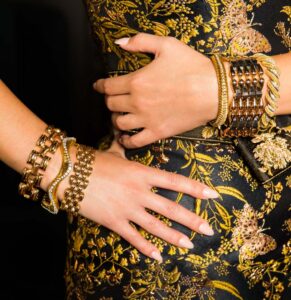
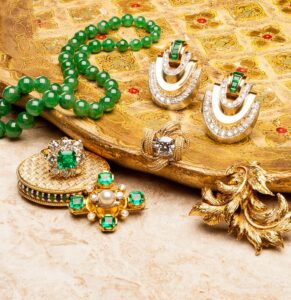
Gemstone Rings
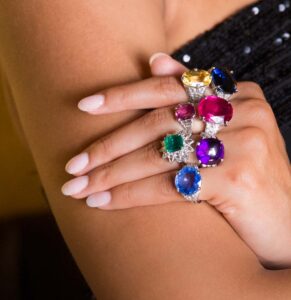
AJU Tiara Jewelry History
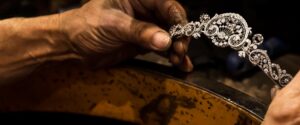
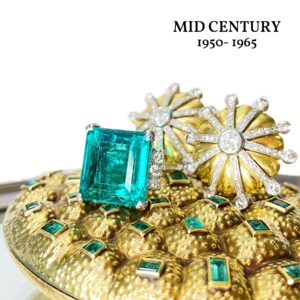
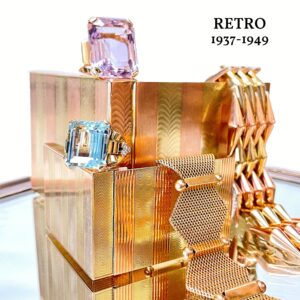

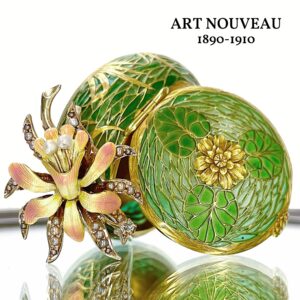

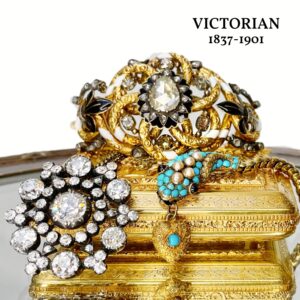
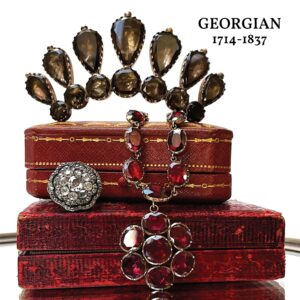
Additional resources:
Lang Antique and Estate Jewelry is the prime destination for vintage jewelry lovers, but you don’t have to be in San Francisco to take advantage of the store’s services. Lang ships jewelry globally and offers Antique Jewelry University, a completely free online guide to maker’s marks and jewelry history. Jewelry historian and Lang co-owner Suzanne Martinez joined the Jewelry Journey Podcast to talk about how Lang curates its huge collection of antique engagement rings; the history of Antique Jewelry University; and what she looks for when evaluating an antique piece. Read the episode transcript here.
Welcome to the Jewelry Journey, exploring the hidden world of art around you. Because every piece of art has a story, and jewelry is no exception.
Sharon: Hello, everyone. Welcome to the Jewelry Journey Podcast. This is the second part of a two-part episode. If you haven’t heard part one, please head to TheJewelryJourney.com. Today, we’re talking with Suzanne Martinez of Lang Antiques in San Francisco. Welcome back.
Do you manufacture yourselves? Does Lang manufacture?
Suzanne: We have what we call our Lange line. Sometimes a piece of jewelry will come in and it’s worn out. It doesn’t have another livelihood, so we can’t guarantee it to a customer. I’m talking about a ring in particular. We have, probably for more than 20 years, been making hand-fabricated rings that are in the style of or influenced by a real ring design. They’re very similar to the older pieces, and we hand fabricate them.
In the last few years, we’ve had a greater demand. People don’t want to pay for the cost of having a ring hand fabricated like the originals. It’s very expensive when a mounting costs more than the diamond you’re setting in it, and that’s not unusual. So, we have done some work with partners that do CAD that have helped us create our designs in CAD, but we do very little of that. 90% of what we do, if we’re going to take an old stone and remake a ring out of it, is hand fabricated. We try and stick to the tenets of the old jewelry that we sell.
Sharon: Do people come in and say, “Can you repolish this stone?” Maybe they have an old ring, a vintage ring, and the stone is beat up but they want it repolished.
Suzanne: That’s a really good question. The stones that get beat up are things that are not a diamond. You have to be pretty hard on a diamond to beat it up or to chip it. But sapphires, if they’ve been worn for 15, 20 years even, they’re going to have some abrasions on them. When we buy a piece of jewelry, that’s one of the things we do. We will remove those stones and repolish them before we resell them.
But as far as a customer coming in with their own personal collection, we don’t have an in-house lapidary, so we don’t do that. There are people that specialize in and help people refurbish like that, but it’s not something we offer because we don’t do it in-house.
Sharon: Was your business affected by COVID?
Suzanne: It was actually positively affected. I think people had more time. We know they had more time at home, and I think people did a lot more screen time. We had a lot more visitors to our website, and people got very excited about antique jewelry, especially colored stones and things they could wear on a Zoom call so people could see their jewelry, like a pair of earrings or a pendant. Business increased because of that, which was very good. I think the awareness grew. People found out about antique jewelry more. Look at Instagram. Instagram is different than it was three years ago, but there were a lot of people spending a lot of time on Instagram and other social media and just watching, because it’s eye candy. People come to our website for the same reason. Who doesn’t like to look at beautiful jewelry?
I just told this story to a customer that came in yesterday. It just came to mind. We used to keep our jewelry in our window. We used to have probably a thousand pieces in the window, tons of jewelry just packed in. I’d watch people walk by. They’d stop in the window, and then they’d walk away with a big smile on their face because jewelry makes people happy. It’s beautiful. I think people gained an appreciation during that time period.
Sharon: Did you see an increase in sales because people didn’t have things to spend the money on?
Suzanne: Well, they weren’t traveling. They weren’t going out to eat, so they were buying jewelry. We were lucky because part of our business is an e-commerce business, and it’s something we’ve done for a long time. I think some of the jewelers that didn’t have that ability to interact with their clients in the same way probably didn’t gain from it. But it was good for our business.
Sharon: When you had a thousand pieces or a lot of jewelry in the window, did you take it out every night?
Suzanne: Oh yeah, every single piece. We had our windows designed so they were modular, so you could take a whole tray of jewelry out and put it on carts and take it to our walls to sell it. We made it work because if you had to take out one at a time, that would take you another couple of hours.
Sharon: Do you have local people, people in San Francisco or in Northern California, who come to the store just to look at the window or to look and see what’s new?
Suzanne: It’s really interesting, because when people come into our store, they’re either going to have an appointment or we’re a destination. They know who we are before they come. They might be coming to see what’s new. They might be coming because they have a particular piece of jewelry they want to look at, and sometimes it’s just part of their trip to San Francisco. They always come to Lang.
Sharon: Do you sell things besides rings, or is it all rings or mostly rings?
Suzanne: No, I would say rings are probably half of what we sell, colored stone and diamond rings, then all other kinds of jewelry. People wear brooches still, believe it or not. We sell a lot of pins and brooches. You don’t see people wearing them as much, but we’re bringing that back. We like them. They’re beautiful, small forms of art, you know?
Sharon: I was intrigued because you used the word collectors. I looked at the store and it was all rings. As I was scrolling through, it seemed like one on every two pages was something that wasn’t a ring.
Suzanne: Well, you have to filter, just like any website you’re on. We have filters set up so that you can choose how you look at different jewelry. If you want to look at rings, if you want to dive in and just look at sapphire rings, if you want to look at Art Deco sapphire rings, you can do all of those things. You can look at all of our jewelry in one page, which is a few thousand pieces that are online. That’s kind of an ominous task. So, filtering is a good way to use our website to find what you’re looking for, or just to look. Like I said, it’s eye candy.
Sharon: How often do you get things that might not be a ring that you would put on the website or people come to the store to see?
Suzanne: If you watch our What’s New page, you’ll see that we sell more things and post more things that are not rings. Rings are maybe 30 to 40% of what we put on our website. There are pendants, earrings, brooches, necklaces, a little bit of everything.
Sharon: In reading the description of your store, that it’s world renowned, it seems like you have everything related to vintage engagement rings or vintage rings.
Suzanne: That is what we’re known for. We have over 800 diamond rings. That’s a large collection of vintage diamond rings. We’ve curated our collection very carefully over the years. People buy from Lang because all of our rings have been fully restored. For example, the prongs are not worn down anymore. We will replace and put new prongs on the ring. If the diamond has a small chip, we remove the diamond and we’ll repair the chip before we put it back in. All of our diamonds of one carat or larger, we send to the GIA for a lab report. We do a lot of work to make sure that the ring we’re selling has all the necessary information for a customer to make a decision on whether they want to buy it.
When you look at an antique diamond, it has a different kind of beauty than a modern round brilliant. Most antique diamonds have a little bit of color to them. They are a J or a K color very commonly, and you have to kind of throw out the standard of the modern round brilliant-cut because you can’t compare them. An old diamond has a different way of reacting with light. It breaks the light up into spectral colors more. It’s just a playful, beautiful diamond, so it doesn’t look like every other round brilliant-cut diamond. Each one is hand cut and unique. To me, that’s a starting point of what makes an antique ring so special.
Then you get the way that the ring is manufactured. They’re hand fabricated, and die striking is a very high-quality way of making a ring. It started because platinum was an expensive metal in the past. Now its price per ounce is less than gold. It’s still harder to work in, but it was always the most expensive metal. It was always 10 times the cost of gold. Because of this, up until 1920, there were no white metals other than silver. White gold hadn’t been patented. It was patented probably in 1918, 1919, but it didn’t get into manufacturing techniques until 1920. If you see somebody that says it’s a Victorian piece of jewelry and it’s white gold, that is the wrong description. There is no way. There was no white gold manufacturing in the 19th century. 1920 is the demarcating line.
After that, they were able to offer white metal jewelry, which was popular in Art Deco, black and white jewelry. This could be offered to people because they were die striking white gold instead of hand fabricating platinum. It still was a high-quality product, but they were using the less expensive white gold versus the platinum. It also justified using a quarter carat diamond, whereas to hand fabricate a platinum ring with a quarter carat, you don’t see that. Well, of what survived. That would be a rarity, to see something under a half carat.
Sharon: Do you have to explain this to a couple that comes in looking for a ring with a modern diamond that was a third of the price or half the price?
Suzanne: Usually, people that are already interested in vintage and antique, older rings, they’re coming for a different reason. They’ve already decided this is what they want. They’re not saying, “Well, why shouldn’t I buy a round brilliant-cut diamond?” But we answer all their questions, and not everybody needs to do a deep dive. If you’re someone who has no background in the jewelry business, to tell them about 1920 and die striking and all that, that may be a little too much information for them. We have it and we’re there to give it to them, but we let the customer guide their own journey and ask the questions. We find it’s a lot easier for them to manage. Does that make sense?
Sharon: Yeah.
Suzanne: And just to clarify another thing, the man doesn’t come in and buy the ring that often. The man and the woman come in together. It’s very common for that. And we have women coming in together and men coming in together. We have all kinds of couples that are buying antique and vintage jewelry.
Sharon: I know how detailed it can be to look at a vintage and everything you’re talking about. I can see myself saying, “Enough already. That’s all I need to know.”
So, you’re a jewelry historian. The Antique Jewelry University was already somewhat started by Christie Romero, but what motivated you to continue to develop it into such an in-depth resource?
Suzanne: Something that I have always done for myself personally, for my staff, with the GIA alumni, it’s all continuing education. Whenever I go to the Tucson Gem and Mineral Show, I go to as many educational presentations as possible. I’ve been involved with the GIA Alumni for over 30 years. We bring speakers to our local chapter and continue their education and elevate people so they know more. There are so many topics as far as jewelry is concerned that it’s just fascinating. You have gem cutters, you have people that manufacture, you have jewelers. What’s your design process? There are so many ways to learn. We have miners that come and speak to us and talk about their journey into the earth and how they extract certain kinds of gems. That’s just barely scratching the surface.
Continuing education is so important to me personally. In order for me to buy jewelry and understand it, I had to learn. How is anyone else going to understand my process so they are confident to buy from Lang? It’s all part and parcel. It’s all education. Someone comes in and, like you said, we do educate them to the degree that they want to be educated. All this information is free. Antique Jewelry University, we’ve never charged for it. We have more than one full-time staff person working on AJU every day. It’s something that we do to give back to our community. It’s very important to me.
Sharon: How do you promote it? How do you let people know about it? Jewelry organizations I’ve been in, we know about it, but how do you let the larger world know it’s available?
Suzanne: It’s kind of an organic process. We share it with our customers in every way we can. I usually speak at least once a year. I’ll speak somewhere, or I will go to a conference and set up a table. My partner in doing this is Starla Turner. We have a table, we’ll bring different rings, we’ll have a card on each ring and say, “Here’s a loupe. Look at it, and this is what you’re going to look for.” Then we have Antique Jewelry University running on a computer, and we have a big poster.
We want people to know about it, but most of the people that use it are in the trade. How do you educate somebody as to what they are buying? Is it authentic? That is a hard thing to do with the public because they don’t have the basic knowledge to start with. So, Antique Jewelry University has many levels. You could be a novice and you just want to come in and find out when a piece was made. My grandmother gave me a locket. When do you think that locket was made? There’s a place for you to find out that information. Then if you want to dive a little deeper, you can. What’s the history of lockets?
Or someone who is a historian themselves, they might want to add to the knowledge they have, or share with us the knowledge they have to help us create a deeper knowledge base on a particular topic. Think of it as tiered information. We have people come to us, whether they’re shopping on our website, or they’ve found out about us through Instagram or Facebook or Pinterest and they want to find out more information, they go to Antique Jewelry University.
Sharon: Could I come to your store and have your staff look at a piece of jewelry and tell me what they think it is?
Suzanne: Absolutely. That’s half the fun of coming to Lang. You get to really look at these pieces. It’s kind of like a museum. You get to look at pieces and they’re for sale. You can touch them. You can have someone tell you about them. It’s fun. It’s really fun.
Sharon: Why did you continue it after Christie passed away?
Suzanne: Christie just did the timeline. That’s what she started. I did the glossary of terms, and she gifted that to us before she died. We included that. I had already started the glossary. I met Christie. The two of us became friends. I call her one of my people. This is why you go to jewelry shows. This is why you go to gem shows. These are your people that understand and have the same passion that you do. She was very passionate. I was really grateful that she was in my life and that we had this part of our journey together.
Sharon: And you just continued adding to it when she wasn’t available to do it.
Suzanne: Yeah. Christie passed about 20 years ago. We’ve been adding content to Antique Jewelry University since the day we started. I think it launched in 2020ish. That’s when we launched the website.
Sharon: Did you ever think it would be such a resource or so big?
Suzanne: Oh, no. It just kind of unfolded. At first it was just, how do you share a library? Let’s just add some things so that people have a resource to find out about what they’re buying. It was more for our customers. Then we realized there’s a huge community out there, whether they’re customers or not, and we all benefit from each other.
We’re a community of people, and everyone that works at Lang is passionate about jewelry. I have gemologists on staff that are just—my friend Starla I was talking about, she’s a black belt gemologist. We have Mary, who is an incredible historian that continues to write articles for Antique Jewelry University. The head of our marketing is Nicole Corsini, and she’s a gemologist as well as, if you pick up the phone and want to talk to her about a piece of jewelry that you’re interested in buying, she will tell you everything about it because she’s got the history. She understands marketing and how to present information to you.
Everybody has something that they are special in as well as the passion. When you shop at Lang, you’re shopping with passionate people that just love what they do. I’m very, very blessed to have all these people. It’s a really special organization.
Sharon: It seems like it. I didn’t know it was so extensive. I knew of Lang and the Antique Jewelry University, but I didn’t realize it was so in-depth and extensive.
Suzanne, thank you for being here today. We really enjoyed it. We learned a lot. thank you very much.
Suzanne: It was my pleasure. Thank you for inviting me. Thank you, Sharon.
Sharon: We will have photos posted on the website. Please head to TheJewelryJourney.com to check them out.
Thank you again for listening. Please leave us a rating and review so we can help others start their own jewelry journey.

